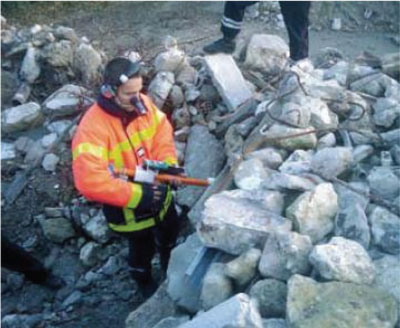by Milt Statheropoulos
Earthquakes, technical failures and explosions are responsible for building collapses that result in victims becoming trapped. Second-Generation Locator for Urban Search and Rescue Operations (SGL for USaR, www.sgl-eu.org) is a mission-oriented project that aims at solving critical problems following massive destruction and large-scale structural collapses in urban locations. Urban search and rescue operations are carried out in a highly hazardous and unstable operating environment, with large numbers of injured, entrapped and vulnerable casualties needing help. In such situations, the first responders called to contribute to the search and rescue operations are usually outnumbered by the large number of collapses that they have to deal with in a short period of time.
SGL for USaR follows a multidisciplinary approach in order to advance the state of the art in a wide spectrum of issues relating to urban search and rescue operations. These include effective and reliable casualty location methods; interoperability of data and systems; coordination between different units and disciplines; effective structural and environmental assessments of conditions in and under the ruins; medical monitoring of trapped casualties; and the location and differentiation of deceased casualties.
The main tasks of the project include: the development of simulation environments for testing location methods and devices; the development and validation of portable devices for search and rescue operations; the development and validation of smart sensors for monitoring conditions under the ruins; the development of an ICT platform that will integrate the received data; the control of the information flow from the field to an operational command and control centre; and the management of medical information, including privacy and bioethics. A first responders’ standalone portable device was designed during the first year of the project and will be developed and validated in the following years. This device will integrate optical, acoustic and chemical methods for locating entrapped victims and detecting hazardous conditions. The portable device will be able to run on-site (field) chemical analysis to detect chemical signatures both from victims and unsafe conditions. Field Chemical Analysis is employed for the first time in search and rescue operations for detecting signs of life as well as chemical signs from dead bodies.

Field operational tests at SDIS84 field terrain, France.
The project will also develop a network of sensors to allow unattended monitoring of the conditions in the ruins of a collapsed building. It will integrate information collected from cameras, microphones and chemical sensors with the aim of detecting signs of life and hazardous conditions signatures in the collapsed building. We are also attempting to develop a distributed and heterogenous wireless sensor network. This network will employ ICT principles such as the Internet Protocol (IP) for long-distance communication among nodes, whereas RF-based technology, being lightweight and with low power requirements, will wirelessly connect short-distance nodes. An Integrated Platform will act as a command and control centre, responsible for managing data acquired by the devices of the network. The platform will integrate all the previous data, ensure interoperability and control the flow of the information from the field to the operational centre. Furthermore, by using special antennas it will provide reliable telecommunication facilities to the first responders.
In SGL for USaR data fusion algorithms will be applied according to the following levels:
1. Sensor fusion on a single device, where each device is equipped with different sensors. Sensors can work cooperatively or complementarily, and in both cases, data fusion brings up a more complete picture of the environment.
2. Sensor fusion over similar devices, where common devices are grouped to cover a larger range.
3. Sensor fusion over different devices, where the type of information is no longer similar. This is the most powerful way of combining sensor information to monitor the environment under the ruins.
This multilevel and multifaceted information fusion system will integrate a number of algorithms for vital sign detection, such as: adaptive threshold detection, adaptive motion detection, image and sound enhancement, image blob detection, alarm assessment, sound and video compression, etc. The corresponding context-dependent soft computing techniques attempt to take advantage of a dataset's strengths while minimizing the impact of its weaknesses. Its context-dependent multilevel algorithmic design is also based on the requirement for processing power, communication bandwidth, power supply and storage features. The general characteristics of this critical system will be interoperability, flexibility, reconfigurability, extensibility, modularity, evolvability and robustness, making it suited to a large field of applications.
For disseminating the results of the project, a Web page has been developed (http://www.sgl-eu.org) in which a technology forum is operating. The basic goal of the forum is to become a platform for the exchange of experience, knowledge and know-how within the SGL for USaR project.
SGL for USaR is an integrated and multidisciplinary project with 21 partners including rescue teams, researchers and SMEs. It is a four-year FP7 security project that started in October 2008. It is coordinated by the National Technical University of Athens, Greece (Field Analytical Chemistry and Technology Unit/FIACTU).
Link:
http://www.sgl-eu.org
Please contact:
Milt Statheropoulos
National Technical University of Athens, Greece
E-mail:










